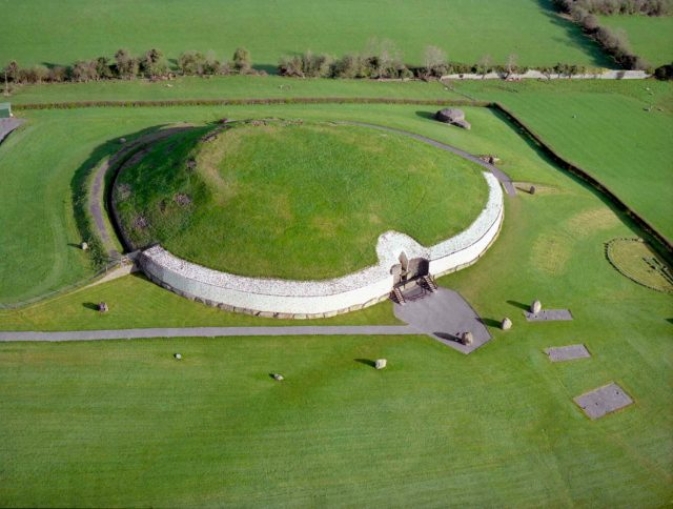Newgrange - Sí an Bhrú

Newgrange (Irish: Sí an Bhrú) prehistoric monument is in County Meath, Ireland (Irish: Contae na Mí, Éire). It is located about 8 kilometres (5.0 mi) west of the eastern coastal town of Drogheda (Irish: Droichead Átha) and on the north side of the River Boyne (Irish: An Bhóinn or Abhainn na Bóinne). It was constructed around 3200 BC, making it older than Stonehenge and the Egyptian pyramids. The site is within the Brú na Bóinne complex which is a World Heritage Site.
Brú na Bóinne is famous for the passage tombs of Newgrange, Knowth and Dowth. These ceremonial structures are among the most important Neolithic sites in the world. They also contain the largest collection of megalithic art in western Europe. Newgrange passage tomb is within a large mound that is approximately 80m in diameter. It is surrounded at its base by a kerb of 97 stones. One of which is the highly decorated Entrance Stone.
The cairn of the monument covers an area of almost 0.5 hectares and is roughly circular. It has been estimated to weigh some 200,000 tonnes in total. The mound covers a single tomb, which consists of a long passage and a cross-shaped chamber. The passage points to the southeast and is just less than 19 m long. It leads in to a chamber with three recesses. This chamber is covered by a corbelled roof which in turn is sealed with a capstone, 6 metres above the floor.
On the floor of the recesses are basin stones. Each of which held human remains. Most of the bones found were cremated. Grave goods of chalk, bone beads, pendants and some polished stone balls were placed with the dead. The entrance stone at Newgrange and Kerbstone 52 at the back of the mound are noted for the quality of decoration. A number of other kerbstones are also carved. Some of the stones within the passage are carved. Particularly noted is the 19th stone on the left and in the back recess of the chamber is the world famous tri-spiral design. Newgrange is known for its ceremonial and spiritual link to the Winter Solstice. There is a small opening or ‘roof box’ situated above the passage entrance. At dawn on the winter solstice, the shortest day of the year (December 21st) and for a number of days before and after, a shaft of sunlight enters the chamber through an opening in the roof box.
It is known that at around 2000 BC, with the arrival of the Beaker people, large wooden enclosures were constructed. Portions of animals were cremated and buried in pits and it is now known as the Pit Circle. The final phase of building at Newgrange was the circle of standing stones that surround the monument. It was erected sometime after 2000 BC and it is thought that it could have had an astronomical purpose.
Link and Image: World Heritage Ireland. and image is courtesy of Brú na Bóinne visitor centre.
Celtic nation:
- Ireland
Itinerary:
- Ireland Leinster north
Place type:
- Ancient site





